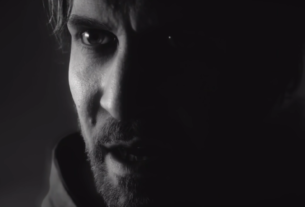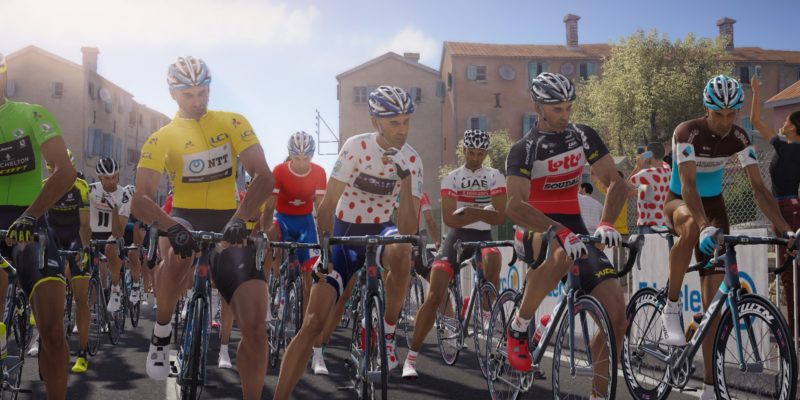
Almost everyone knows their way around a bike (or at least understands how it works), but professional cycling is an entirely different beast. One is doing laps around the parking lot with your hometown homies. The other is slipstreaming with one hand on a handlebar, the second hand squeezing isotonic gel down your throat in preparation for an aggressive attack to break away from the peloton. If there’s anything Tour de France 2020 should get credit for, it’s being my enthusiastic but patient teacher.
Each entry in Cyanide’s annual racing series has seen mild improvements over the previous years’. But, like with most annualized franchises, these small, incremental changes are met with a lukewarm fan response. Regardless, the 2020 iteration is the latest and therefore best entryway into the world of pro cycling. Tour de France 2020 is undoubtedly a competent, and faithful, simulation game.
The framework for something great is there, but it’s marred by lack of polish and systems held together scotch tape and school glue. My current stance on the game is already miles more positive than it was a few days prior. That first stage race was a head scratcher, but Tour de France 2020 never gave up on its student.
The supreme cycling simulator
A spoiled kid, coming off of F1 and Forza, I couldn’t have anticipated these visuals. The game features a single racer model with different team jerseys painted onto his slim, shiny body. Stiffly-animated fans line the roads to distract from the drab, empty environments of each stage race. The racers follow suit, with their own set of awkward animations. Tour de France 2020 is in dire need of facelift; its flat textures, lighting, and post-processing contribute to a severely outdated visual experience.
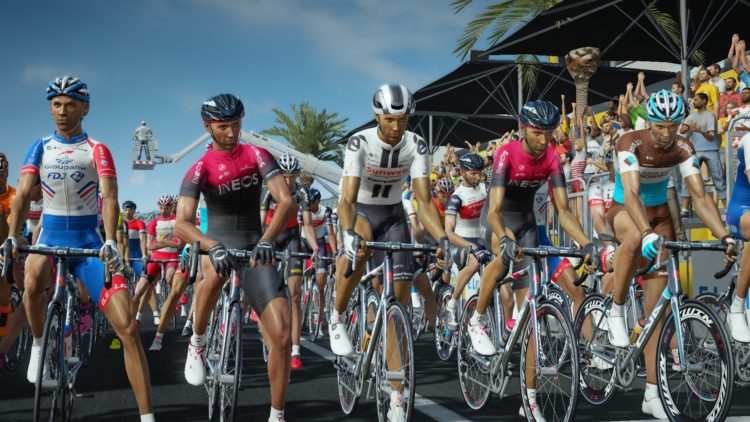
Just me and the boys.
Your team manager’s quips and the adaptive race commentary inject some life into the game when its visuals can’t. To no one’s surprise, where the game shines isn’t in its visuals, though watching the same character model stumble up onto the podium makes it difficult to ignore. Tour de France 2020’s bread and butter is its nuanced, team-oriented race mechanics. This is obvious to the series’ dedicated fans, but newcomers such as myself may have a little trouble staying on track.
Pedal to the metal
Tour de France 2020 is the first in the franchise to hit PC, and offers no mouse and keyboard support. Cyanide has a rather extensive catalog of games on PC, so this came as a bit of shock. This is likely a result of the cyclists’ pressure-sensitive acceleration/deceleration, which requires controller triggers. Naturally, the harder you pedal, the more stamina you lose. Each cyclist on your team has limited stamina with a nasty regeneration time, meaning cycling through them is crucial.
Every cyclist has their own strengths, whether that be sprinting, climbing, or others, and should be put to work when it’s their time to shine. Breakaway specialists can attack for as long as their attack meter allows, breaking away from the group, or peloton, and catching an early lead. Members of the team are given consumable “feed” to aid in stamina and attack recovery. Feed is replenished at various checkpoints during the stage race.

This road ain’t big enough for the 160 of us.
To survive this battle of attrition with your team, slowing stamina consumption while maintaining a steady pace is key. One safe bet is to toggle a follow mode and ride in another racer’s slipstream. Bearing the brunt of the oncoming wind yourself is a recipe for disaster. When going downhill, take your feet off the pedals and assume a more aerodynamic position. If you find yourself in a smaller breakaway group, you have no choice but to work with your opponents so that all of you can maintain a lead.
Rider’s high
Tour de France 2020 features a blend of flat, hilly, and mountain stages, with sections in each that demand a certain type of cyclist. The team commands menu pauses the action and lets you choose between different cyclists on your team. Additionally, you can issue commands to your teammates to protect others, consume fuel, up their tempo, attack, and more. Though this is a team sport, points are scored for individual placements. Use teammates effectively to ensure that a few can place high at the end of the stage race, putting your team in a better position for the next stage.
Whipping down a hill and slicing through the wind. Making that crucial breakaway with two other cyclists. When Tour de France 2020 hits its stride, it’s an incredible experience. For these brief moments, the game ranks among the best that sports gaming has to offer. But races are more often than not defined by lengthy adrenaline droughts. Luckily, the fast-forward feature allows you to skip through the expansive valleys and get back to the peaks. Tracks sit at well over 100 kilometers, taking up huge swaths of time if you let them. Fast-forward too often, however, and you’ll find yourself consistently in last place.
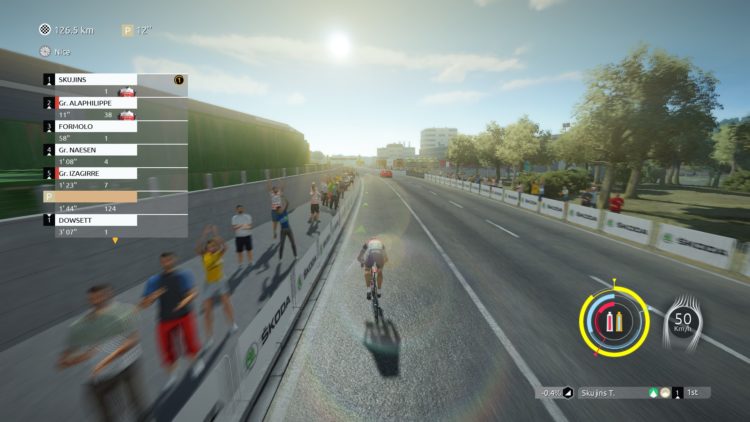
Tired, lost, and afraid.
Teamwork almost makes the dream work
There’s a lot to process and even more to keep track of, but the UI is quite the mess. Various meters start and stop in different locations, swirl around a center point where two more meters sit. The team interface is exceptionally poor, forcing you to pause the race for absurd amounts of time while you sift through the list of cyclists and issue commands. If only there were an easy way to issue commands on the fly. The often-cluttered interface doesn’t instill much confidence in the player, especially new players already overwhelmed by the micromanagement.
At times, it feels as if the race is entirely out of your control. You learn very quickly that the AI is not to be trusted. Watching them in fast-forward is a painful experience punctuated by continuous blow-ups (running out of stamina) and a steady drop in placement. Commands you issue to your teammates feels like placating unruly children; taking control of the cyclist is the only sure-fire method. The solo racing experience is reliable and engaging, but the smorgasbord of issues introduced with teams throws a wrench into the experience. It’s even more devastating watching the effortless cooperation among cyclists in other AI teams.
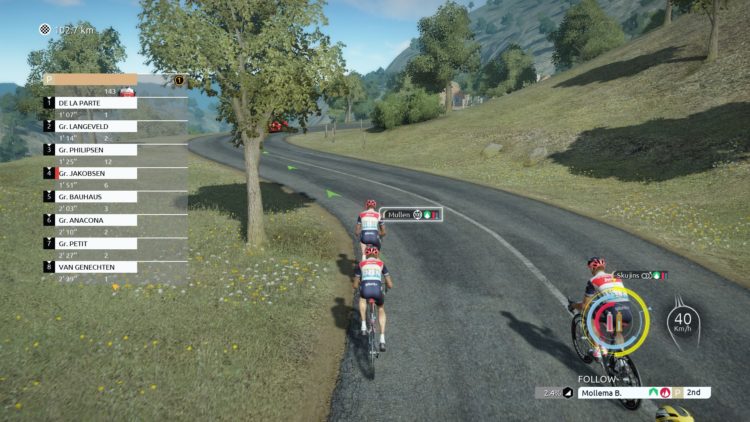
Friends have each other’s backs.
Gauging interest
Tour de France 2020 offers a number of modes to keep you pedaling with purpose. In the pro leader mode, you can create your own custom cyclist (read: the same racer model again) and become the greatest cyclist the sport has ever seen. You complete objectives to boost your cyclist’s stats and work with your team to elevate them to the top of the podiums. In the similar pro teams, make your team manager proud and earn points to be invited to more races. The race mode features a selection of road cycling races for you to tackle separately, while the challenge mode offers short sprints and downhill time trials.
While there’s plenty on display, Tour de France 2020 is without the in-depth customization associated with contemporary simulation games. Stage races are also plenty diverse, but given their length which leads to lulls between any changes in pace, the moment-to-moment gameplay feels eerily the same across all races. It bears repeating that this is a game for those who already enjoy the sport. The game succeeded in that I’m more interested in the actual Tour de France than I’ve ever been. It’s a solid distillation of pro cycling, but not engaging enough to justify playing so many stage races in succession.
Tour de France 2020
It’s a solid distillation of pro cycling, but not engaging enough to justify playing so many stage races in succession.


